Air plants, also known as epiphytes, are unique plants that don’t require soil to grow. Instead, they absorb nutrients and water from the air around them through their leaves.
There are over 600 types of air plants, with some of the most popular including Tillandsia, Bromeliads, and Orchids.
Air plants have a rich history that dates back to the Aztecs and the ancient Mayans, who used them for medicinal and spiritual purposes. There are many air plants benefits which we simply can’t ignore for a better healthy lifestyle.
These plants also hold cultural significance in other parts of the world, such as Japan, where they are thought to bring good luck. This article explores the benefits of air plants and how they can enhance your life.
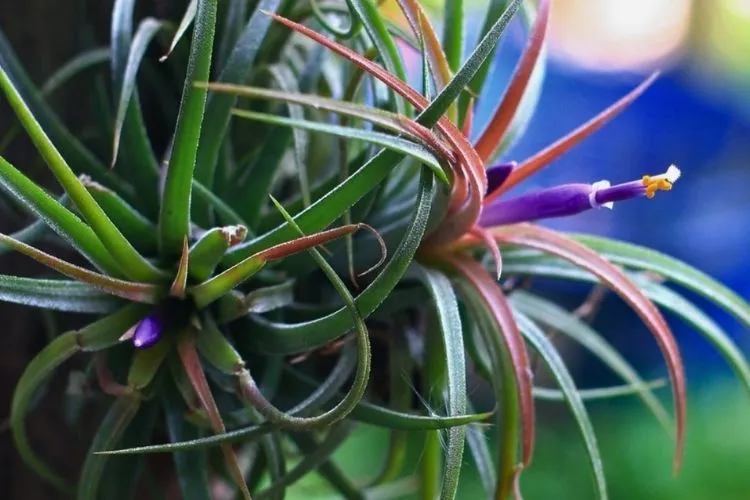
From purifying indoor air to boosting mood and productivity, air plants are an excellent addition to any home or office. We will also touch on choosing the right air plant, displaying them creatively, and caring for them properly.
Table of Contents
All Air Plants Benefits Explained in Detail
Air plants are more than just unique and beautiful decorative elements; they also offer a range of benefits for our health and well-being. Air plants have a lot to offer, from purifying indoor air to boosting mood and productivity.
In this section, we will detail the many benefits of air plants, exploring the different ways they can enhance our lives.
We will cover the health benefits of air plants and their decorative advantages and provide tips for incorporating air plants into your life.
Health Benefits of Air Plants
Air plants are not just beautiful decorative elements, but they also have a positive impact on our health. Let’s have a look at and discuss some of the most promising health benefits of air plants in this section:

Purify indoor air
Air pollution is a significant concern in modern times, especially for those living in urban areas. Indoor air quality is equally important, as we spend most of our time indoors.
Air plants are a great alternative for improving indoor air quality by removing harmful toxins and pollutants from the air.
These types of plants absorb these pollutants through their leaves and convert them into nutrients through a process called photosynthesis. This makes the air around us cleaner and healthier to breathe.
Some common toxins that air plants can remove include benzene, formaldehyde, and xylene.
Compared with other air purifiers, air plants are a more sustainable and eco-friendly option. They don’t require electricity or filters to purify the air, making them a cost-effective choice for those concerned about their environmental impact.
Regarding air-purifying plants, some air plants are more effective than others. For example, Tillandsia Ionantha, Tillandsia Bulbosa, and Tillandsia Xerographica are some of the best air plants for air purification.
They are particularly effective at removing formaldehyde, a common indoor pollutant in household items like cleaning products and furniture.
By incorporating air plants into your home, you can breathe cleaner and healthier air and reduce the risk of developing health problems caused by poor indoor air quality.
Boost Mood and Productivity
Air plants not only purify the air around us but also positively impact our mental health. Plant exposure can have a calming effect and make us feel more relaxed. Research has shown that air plants can reduce stress, anxiety, and depression while boosting mood and productivity.
One reason is that air plants can help create a sense of calm and serenity in our surroundings. Their presence can make us feel more relaxed and less stressed, helping us to stay focused and productive.
In addition, caring for air plants can also have a therapeutic effect, providing a sense of purpose and satisfaction.
Research studies have also supported the positive impact of plants on our mental health. For example, a study published in the Journal of Environmental Psychology found that indoor plants like air plants can reduce stress and improve cognitive function, memory retention, and task performance.
Tillandsia Caput Medusae, Tillandsia Stricta, and Tillandsia Brachycaulos are some of the best air plants for boosting mood and productivity. They are known for their calming and soothing effects and can help to create a relaxing environment.
Incorporating these air plants into your workspace or home office can improve your mental state and become more productive.
Reducing Stress and Anxiety
Stress and anxiety are fast becoming common occurrences in many of our lives. Air plants can offer a natural and effective way to reduce these negative emotions. One of the main ways air plants reduce stress and anxiety is by creating a sense of calm and relaxation in our surroundings.
Air plants are natural air purifiers that can remove toxins, promoting a healthy and peaceful environment. In addition, studies have shown that simply being in the presence of plants can reduce stress and anxiety, lower blood pressure, and improve overall mood.
Research studies have also demonstrated the effectiveness of air plants in reducing stress and anxiety. A study published in the Journal of Physiological Anthropology found that interacting with indoor plants like air plants can reduce psychological and physiological stress in humans.
Tillandsia fuchsii, Tillandsia Tectorum, and Tillandsia Straminea are some of the best air plants for reducing stress and anxiety.
They are known for their calming and soothing effects and can help to create a relaxing environment.
Decorative Benefits of Air Plants
In addition to their health benefits, air plants also offer a range of decorative advantages. With their unique shapes, sizes, and colors, air plants can enhance the look and feel of any living space.
From creating eye-catching centerpieces to decorating walls and shelves, air plants provide a versatile and attractive way to add a natural touch to your home or office.
In this section, we will discuss the different ways air plants can enhance your interior design and their low maintenance and cost-effectiveness. We will also provide tips for caring for air plants and incorporating them into your DIY projects.
Enhancing Interior Design
Air plants are great for our health and offer a range of decorative advantages. With their unique shapes, sizes, and colors, air plants can enhance the look and feel of any living space.
Air plants enhance interior design by adding a natural and organic touch to your home decor. This provides a refreshing and inviting ambiance to your living spaces and creates a peaceful and calming environment.
There are many different ways to display air plants in your home, making them a supremely versatile and attractive decoration.
For example, you can use glass globes, terrariums, driftwood, or wire to create a unique and eye-catching display. By choosing the right air plants and displaying them creatively, you can enhance the look and feel of any room in your house.
Some of the best air plants for interior design include Tillandsia Xerographica, Tillandsia Bulbosa, and Tillandsia Stricta.
These air plants have unique shapes and textures that can add interest and intrigue to any space. Incorporating these air plants into your home decor allows you to enjoy a more natural and inviting living space.
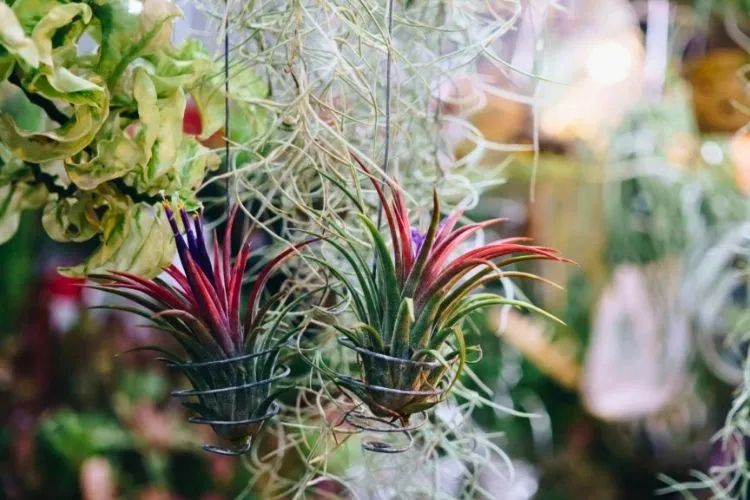
Low Maintenance and Cost-Effective
Air plants are beautiful and good for your health, but they are also incredibly low maintenance and cost-effective. One of the main reasons people choose air plants for their home or office is that they require very little care or attention.
Unlike traditional houseplants, air plants don’t need soil to grow and absorb moisture and nutrients through their leaves.
Air plants are also cost-effective since they don’t require expensive soil, pots, or fertilizers. They can thrive in a variety of environments and can be grown in creative and unique ways, making them an affordable and practical option for any sized budget.
To care for air plants, providing them with the right amount of water, light, and air circulation is essential. A spray bottle can be used to water air plants and should be placed in a location with bright, indirect light. Avoid placing air plants in direct sunlight, as this can damage their leaves.
Some of the best air plants for low maintenance and cost-effectiveness are Tillandsia Bulbosa, Tillandsia Ionantha, and Tillandsia Juncea. These air plants are easy to care for and can thrive in various environments.
By choosing these air plants and providing them with the right care, you can enjoy a beautiful, low-maintenance decoration in your home or office.
How to Incorporate Air Plants into Your Life?
Now that you know about the different health and decorative benefits of air plants, you may wonder how to incorporate them into your life.
This section will discuss the factors to consider when choosing an air plant, the best places to purchase them, and the different ways to display them.
We will also provide tips for caring for air plants and incorporating them into your DIY projects. By the end of this section, you’ll have all the information you need to start incorporating air plants into your life and reaping their benefits.
Choosing the Right Air Plant
When choosing the right air plant for your home or office, there are several factors to consider. Air plants come in various shapes, sizes, and colors, so it’s essential to find the one that will thrive in your specific environment.
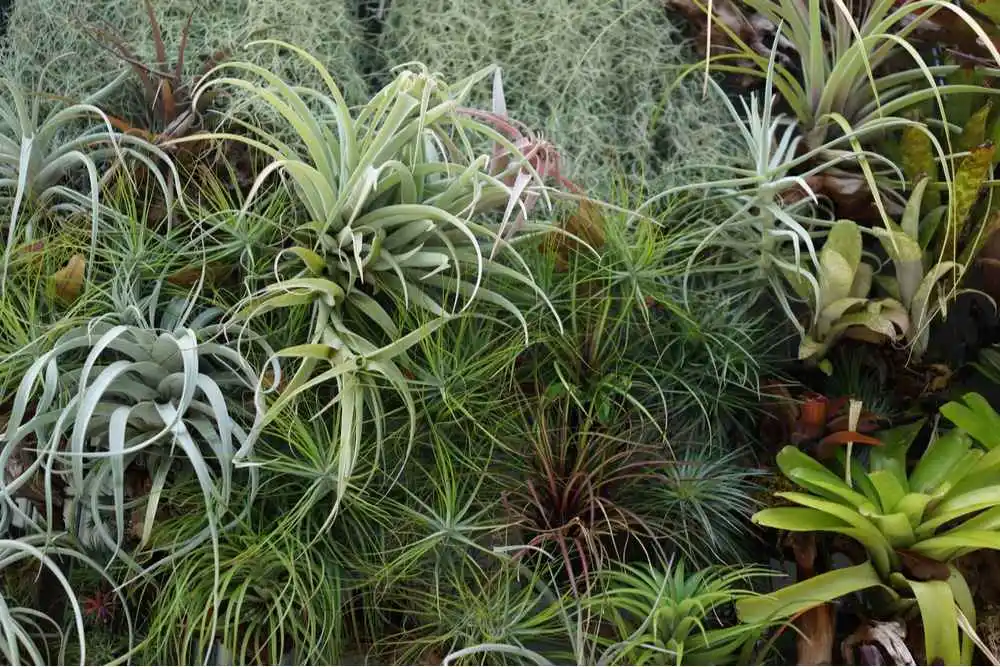
Factors to consider when choosing an air plant
- Lighting and temperature requirements: Different air plants have different lighting and temperature requirements. Some air plants prefer bright, indirect light, while others can tolerate lower light conditions. It’s important to consider the lighting and temperature in your space when choosing an air plant.
- Size and shape of the plant: Air plants come in many different sizes and shapes, from small and round to large and spiky. Choosing an air plant that will fit well in your display area and complement your interior design is important.
- Watering requirements: Air plants absorb moisture through their leaves, so they don’t require soil or regular watering. However, they do need to be misted or soaked in water regularly to keep them healthy.
Best places to purchase air plants
- Online nurseries: Many online nurseries offer various air plants that can be shipped directly to your doorstep. This is a convenient and easy way to purchase air plants, especially if you’re looking for specific varieties.
- Local nurseries and garden centers: Local nurseries and garden centers often carry a selection of air plants you can see and touch before purchasing. This can be helpful if you’re new to air plants and want to learn more about them before purchasing.
Displaying Air Plants
Once you have chosen the right air plants for your space, it’s time to start displaying them. There are many different ways to display air plants, depending on your style and available space.
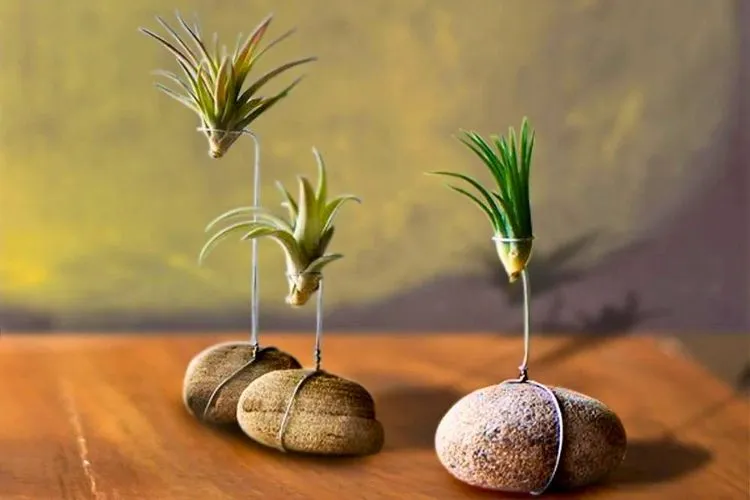
Different ways to display air plants
- Using terrariums and glass globes: Terrariums and glass globes are popular for displaying air plants. They create a unique and eye-catching display and can be hung or placed on a surface. They also help to create a humid environment in which air plants thrive.
- Creating vertical gardens: Vertical gardens are a great way to display multiple air plants and create a living wall. They can be made using various materials, including wood, metal, and mesh. They are perfect for small spaces and can add a touch of nature to any room.
- Mounting air plants on driftwood or rocks: Mounting air plants on driftwood or rocks is a great way to create a natural and organic display. It can also help to mimic the air plants’ natural habitat and make them feel at home.
Tips for creating an eye-catching display
- Choosing complementary colors and textures: When creating a display, it’s important to consider the colors and textures of your air plants and display materials. Try to pick colors and texture types that help to highlight each other and create an original, cohesive look.
- Creating a balanced arrangement: A balanced arrangement is visually pleasing and harmonious. This can be achieved by using different sizes and shapes of air plants and different materials and textures.
Caring for Air Plants
Air plants are relatively low-maintenance, so you won’t need to put extreme effort in to ensure they stay alive. However, to keep them healthy and thriving, providing them with the right conditions and care is important. Let’s go over the basic principles so that your air plant can thrive in all its glory.
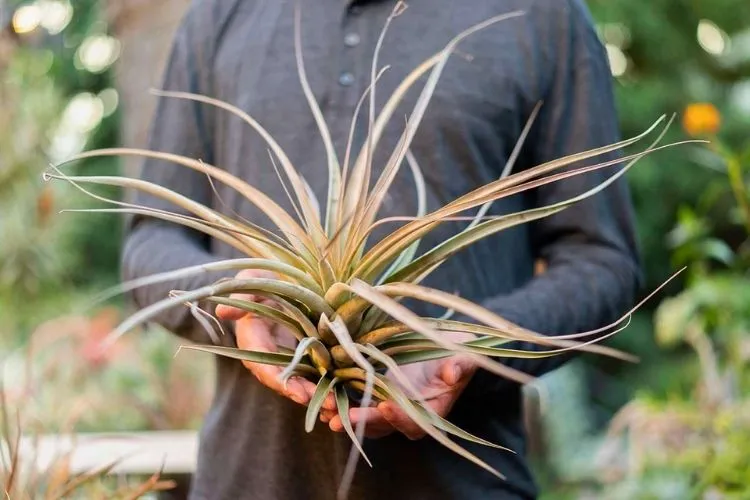
Watering frequency and methods
Air plants don’t need soil to grow, but they do need water to survive. The frequency and method of watering will depend on the species of air plant, as well as the environment they are in. As a general rule, air plants should be watered once a week. You can water your air plants by soaking them for 30 minutes or misting them with a spray bottle.
Lighting and temperature requirements
Air plants thrive in bright, indirect light. Direct sunlight can damage their leaves and cause them to dry out. They also prefer temperatures between 50-90°F (10-32°C). Avoid exposing your air plants to extreme temperatures or drafts.
Pruning and propagation tips
Air plants don’t require pruning, but you can remove dead or damaged leaves to keep them looking their best. If your air plant has produced a pup (baby plant), you can remove it and grow it into a new plant. To do this, gently twist the pup from the mother plant and place it in a new location. Provide it with a moist, humid environment to produce roots before establishing itself and continuing to grow.
Using Air Plants in DIY Projects
Air plants are versatile plants that can be used in various DIY projects to create unique and eye-catching decor. Here are some cool and innovative ideas for incorporating air plants into your DIY projects:

Creating living wall art
Air plants can create some pretty interesting living wall art that adds a unique touch to your home decor. To create living wall art, you can mount air plants on a wire frame and hang it on the wall. You can add other elements like moss, twigs, or flowers to create a more natural look.
Making a hanging air plant chandelier
A hanging air plant chandelier is a surprisingly beautiful way to display air plants in your home. To make a project such as this, you use a wire basket and attach air plants to it using wire or some fishing line. You can add other decorative elements like beads or crystals to create a more elegant look. The only limit is your imagination.
Crafting a unique air plant terrarium
An air plant terrarium is a small, enclosed container that holds air plants and other decorative elements. You can use a glass container, like a mason jar or fishbowl, and add elements like sand, rocks, or shells to create a unique terrarium. You can also add other decorative elements like fairy lights or miniature figurines.
When creating DIY projects with air plants, it’s important to choose the right materials and follow instructions carefully to ensure the health of your air plants. Make sure to use safe materials for air plants and avoid using harmful chemicals or pesticides.
Frequently Asked Questions (FAQs)
How do air plants survive without soil?
Air plants absorb water and nutrients through their leaves, so they don’t require soil to survive. They can be grown in various ways, including mounted on driftwood or placed in a terrarium.
How often do you need to water air plants?
The watering frequency for air plants depends on the species and the environment. Air plants should be misted or soaked in water once a week, but this can vary depending on factors like humidity and temperature.
Can air plants grow outdoors?
Air plants can be grown outdoors, and exposed to warm, humid climates. They should be protected from direct sunlight and frost and can be attached to trees or other natural surfaces.
Do air plants need sunlight?
Air plants need around 3-4 hours of bright, indirect light daily to thrive. They should be kept out of direct sunlight, which can scorch their leaves. They can be grown indoors near a window or outdoors in a shaded area.
Conclusion:
In summary, air plants offer numerous benefits, from improving air quality to enhancing mood and productivity. They are also low-maintenance and can be incorporated into your decor creatively. We encourage you to try air plants and see how they can enrich your life.
We hope that this guide on air plants benefits has been helpful. You can read about similar topics here on our website. Check back again soon for more.

